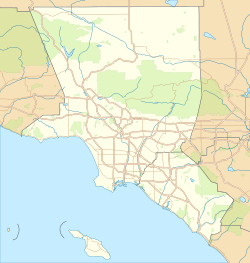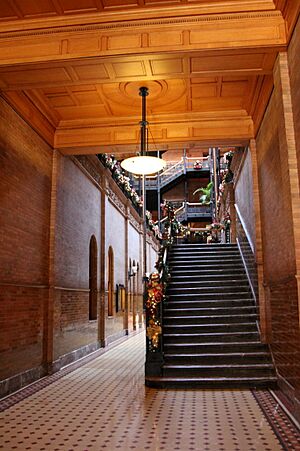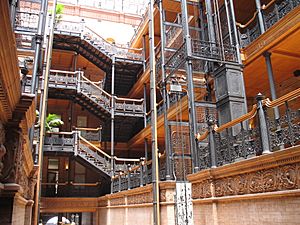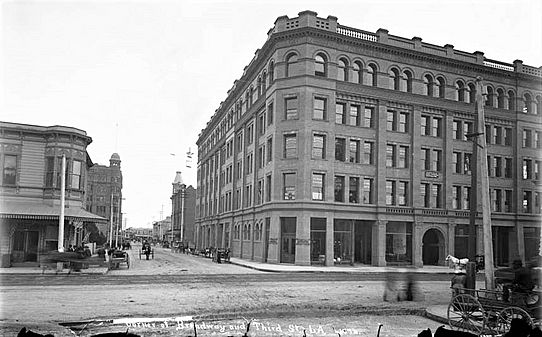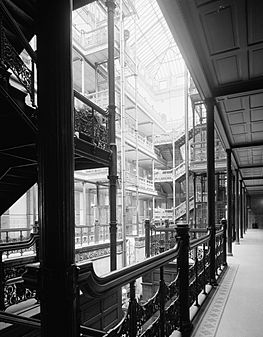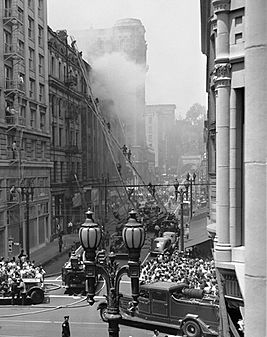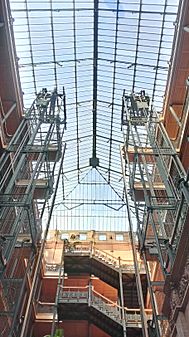Bradbury Building facts for kids
|
Bradbury Building
|
|
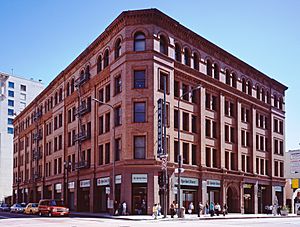
From the corner of West 3rd Street and South Broadway (2005)
|
|
| Location | 304 South Broadway Los Angeles, California |
|---|---|
| Built | 1893 |
| Architect | Sumner Hunt, George Wyman |
| Architectural style | Italian Renaissance Revival, Romanesque Revival, Chicago School |
| NRHP reference No. | 71000144 |
Quick facts for kids Significant dates |
|
| Added to NRHP | July 14, 1971 |
| Designated NHL | May 5, 1977 |
The Bradbury Building is a famous building in downtown Los Angeles, California. Built in 1893, this five-story office building is known for its amazing central area. It has a glass roof, cool walkways, stairs, and elevators. All of these feature fancy metal designs.
A rich gold-mining millionaire, Lewis L. Bradbury, asked for the building to be made. George Wyman, a designer, built it based on an idea by Sumner Hunt. The building has appeared in many movies, TV shows, and music videos.
It was added to the National Register of Historic Places in 1971. In 1977, it became a National Historic Landmark. This is a special honor given to important places. It is also the oldest building in Los Angeles to be named a city landmark.
Contents
History of the Bradbury Building
How the Building Started
Lewis L. Bradbury (1823–1892) was a very rich man. He owned a gold mine in Mexico. Later in his life, he started buying and selling land. In 1892, he planned to build a five-story building in Los Angeles. It would be near the Bunker Hill area.
He first hired an architect named Sumner Hunt to design it. But Bradbury did not like Hunt's plans. He wanted something grander. So, he hired George Wyman, who worked for Hunt. Wyman was not a trained architect. He was earning only $5 a week at the time. Bradbury felt Wyman understood his big vision better. The building opened in 1893, after Bradbury had passed away. It cost $500,000 to build, which was much more than planned.
The 20th Century and Beyond
The Bradbury Building has mostly been used for offices. In the early 1980s, a developer named Ira Yellin bought it. He spent $7 million to fix it up and make it safe from earthquakes. This work happened between 1989 and 1991. During this time, a new back entrance was added. This connected the building to a park and a parking garage. New lights were also put in, with special alabaster lamps from Spain.
Since 1996, parts of the building have been used by government groups. These include a division of the Los Angeles Police Department.
In 2003, an investor from Hong Kong bought the building for $6 million. The building was not openly for sale. It was only offered to people who would respect its history. This shows how much people care about keeping its special look.
From 2001 to 2003, the Museum of Architecture and Design was located here. In 2007, an art gallery opened in the building. As of 2018[update], the Berggruen Institute also has offices there.
Inside the Bradbury Building
From the outside, the Bradbury Building looks simple. It has brown brick, sandstone, and terra cotta details. But the inside is what makes it famous.
You enter through a small, dark lobby. This lobby then opens up into a bright, tall central area. It feels like a grand hall. An actor named Robert Forster described it well. He said, "Outside it doesn't look like much. But when you walk inside, suddenly you're back a hundred and twenty years."
The five-story central area is very colorful. It has yellow and pink bricks, fancy cast iron, and beautiful tiles. There's also Italian marble and polished wood. A huge skylight at the top lets in lots of natural light. This creates changing shadows throughout the day. When the building was new, it had the biggest plate-glass windows in Los Angeles.
You can ride open "bird-cage" elevators up to the top floor. These elevators are surrounded by beautiful wrought-iron designs. The building also has staircases with cool patterns. They have wrought-iron and polished oak railings. The wrought-iron was made in France. It was shown at the 1893 Chicago World's Fair before being put in the building. Even the mail chutes have fancy metalwork. All these details make the building look amazing and complex.
Visiting the Bradbury Building
The Bradbury Building is a popular place for tourists to visit. It is open every day. A staff member is usually there to share facts about its history. Visitors can go up to the first landing. You can also find brochures and take tours.
It is close to other famous spots in downtown Los Angeles. These include the Grand Central Market, the Million Dollar Theater, and Angels Flight. You can get there easily by taking the Los Angeles MTA Red Line train.
Gallery
Images for kids
See also
 In Spanish: Bradbury Building para niños
In Spanish: Bradbury Building para niños


